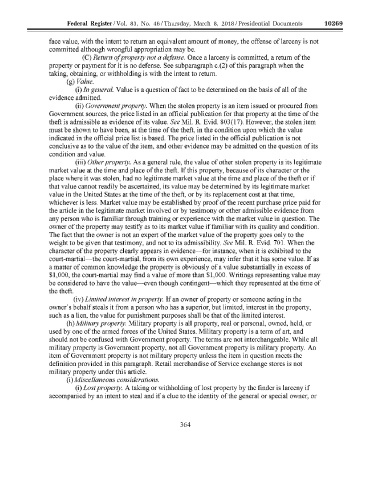Page 566 - Trump Executive Orders 2017-2021
P. 566
Federal Register / Vol. 83, No. 46 / Thursday, March 8, 2018 / Presidential Documents 10269
face value, with the intent to return an equivalent amount of money, the offense oflarceny is not
committed although wrongful appropriation may be.
(C) Return of property not a defense. Once a larceny is committed, a return of the
property or payment for it is no defense. See subparagraph c.(2) of this paragraph when the
taking, obtaining, or withholding is with the intent to return.
(g) Value.
(i) In general. Value is a question of fact to be determined on the basis of all of the
evidence admitted.
(ii) Government property. When the stolen property is an item issued or procured from
Government sources, the price listed in an official publication for that property at the time of the
theft is admissible as evidence of its value. See Mil. R. Evid. 803(17). However, the stolen item
must be shown to have been, at the time of the theft, in the condition upon which the value
indicated in the official price list is based. The price listed in the official publication is not
conclusive as to the value of the item, and other evidence may be admitted on the question of its
condition and value.
(iii) Other property. As a general rule, the value of other stolen property is its legitimate
market value at the time and place of the theft. If this property, because of its character or the
place where it was stolen, had no legitimate market value at the time and place of the theft or if
that value cannot readily be ascertained, its value may be determined by its legitimate market
value in the United States at the time of the theft, or by its replacement cost at that time,
whichever is less. Market value may be established by proof of the recent purchase price paid for
the article in the legitimate market involved or by testimony or other admissible evidence from
any person who is familiar through training or experience with the market value in question. The
owner of the property may testify as to its market value if familiar with its quality and condition.
The fact that the owner is not an expert of the market value of the property goes only to the
weight to be given that testimony, and not to its admissibility. See Mil. R. Evid. 701. When the
character of the property clearly appears in evidence-for instance, when it is exhibited to the
court-martial-the court-martial, ±rom its own experience, may infer that it has some value. If as
a matter of common knowledge the property is obviously of a value substantially in excess of
$1,000, the court-martial may ±ind a value of more than $1,000. Writings representing value may
be considered to have the value--even though contingent-which they represented at the time of
the theft.
(iv) Limited interest in property. If an owner of property or someone acting in the
owner's behalf steals it from a person who has a superior, but limited, interest in the property,
such as a lien, the value for punishment purposes shall be that of the limited interest.
(h) Military property. Military property is all property, real or personal, owned, held, or
used by one of the armed forces of the United States. Military property is a term of art, and
should not be confused with Government property. The terms are not interchangeable. While all
military property is Government property, not all Government property is military property. An
item of Government property is not military property unless the item in question meets the
definition provided in this paragraph. Retail merchandise of Service exchange stores is not
military prope1iy under this article.
(i) Miscellaneous considerations.
(i) Lost property. A taking or withholding of lost property by the finder is larceny if
accompanied by an intent to steal and if a clue to the identity of the general or special owner, or
sradovich on DSK3GMQ082PROD with PRES DOCS VerDate Sep<11>2014 18:39 Mar 07, 2018 Jkt 244001 PO 00000 Frm 00383 Fmt 4705 Sfmt 4790 E:\FR\FM\08MRE0.SGM 08MRE0 ER08MR18.385</GPH>
364

